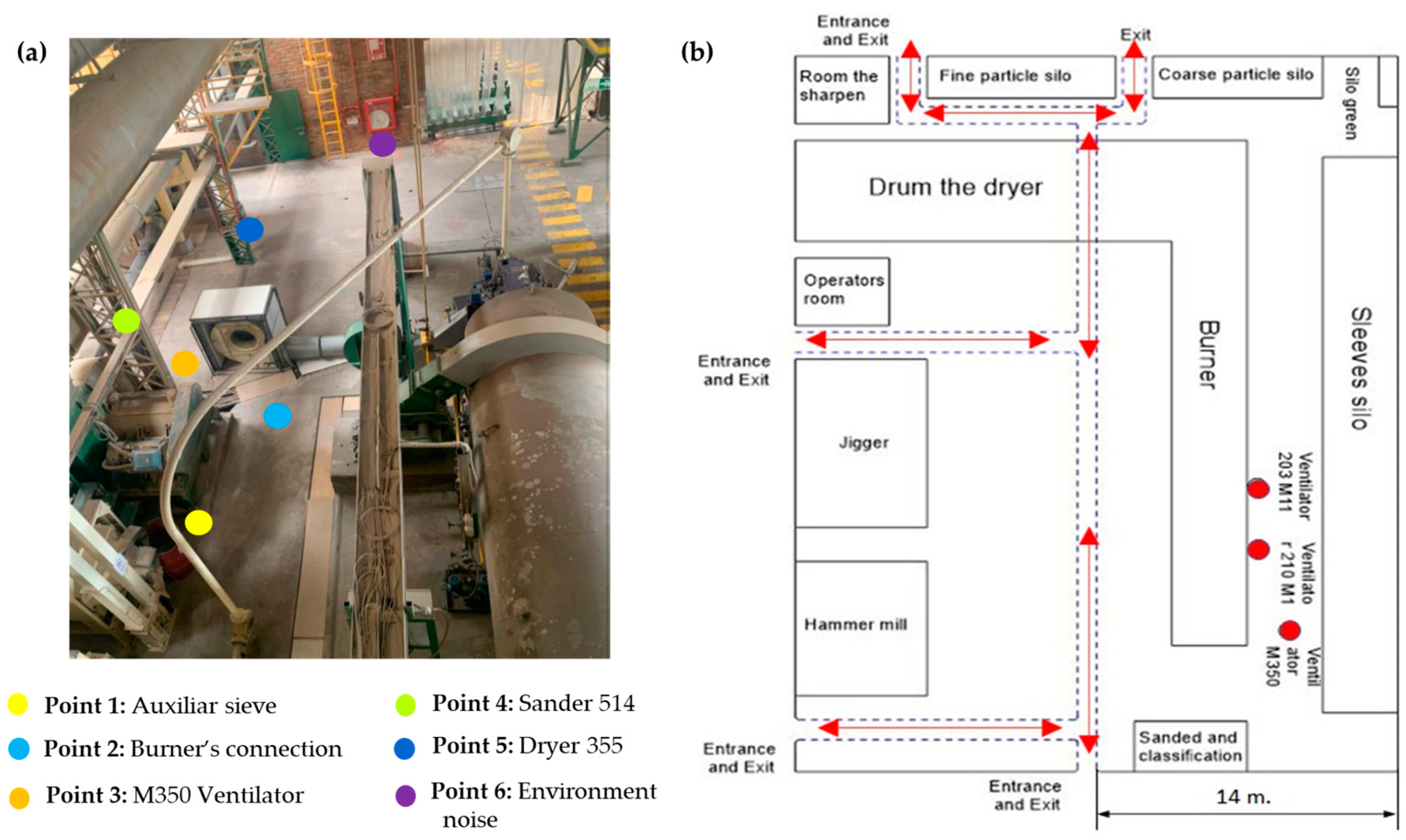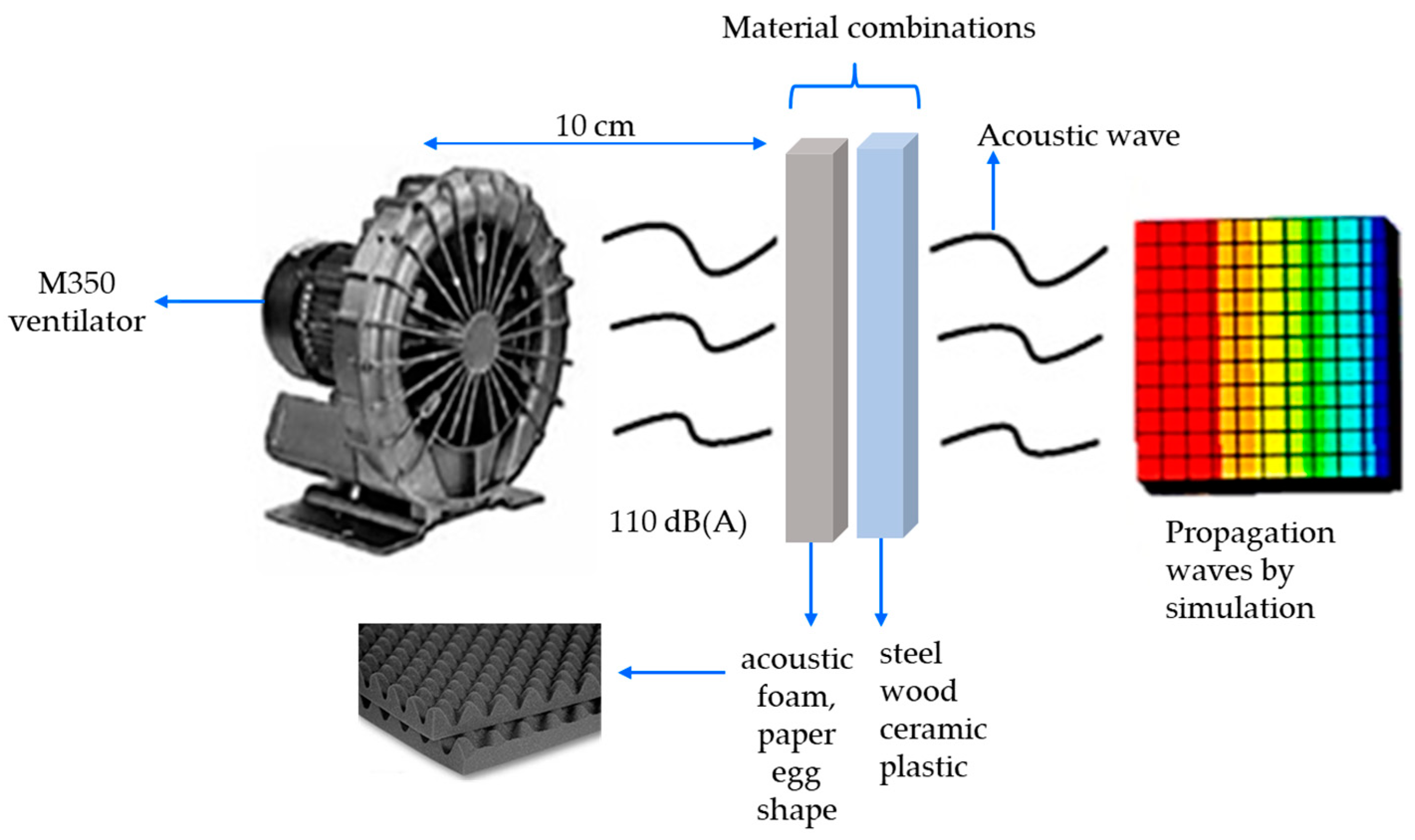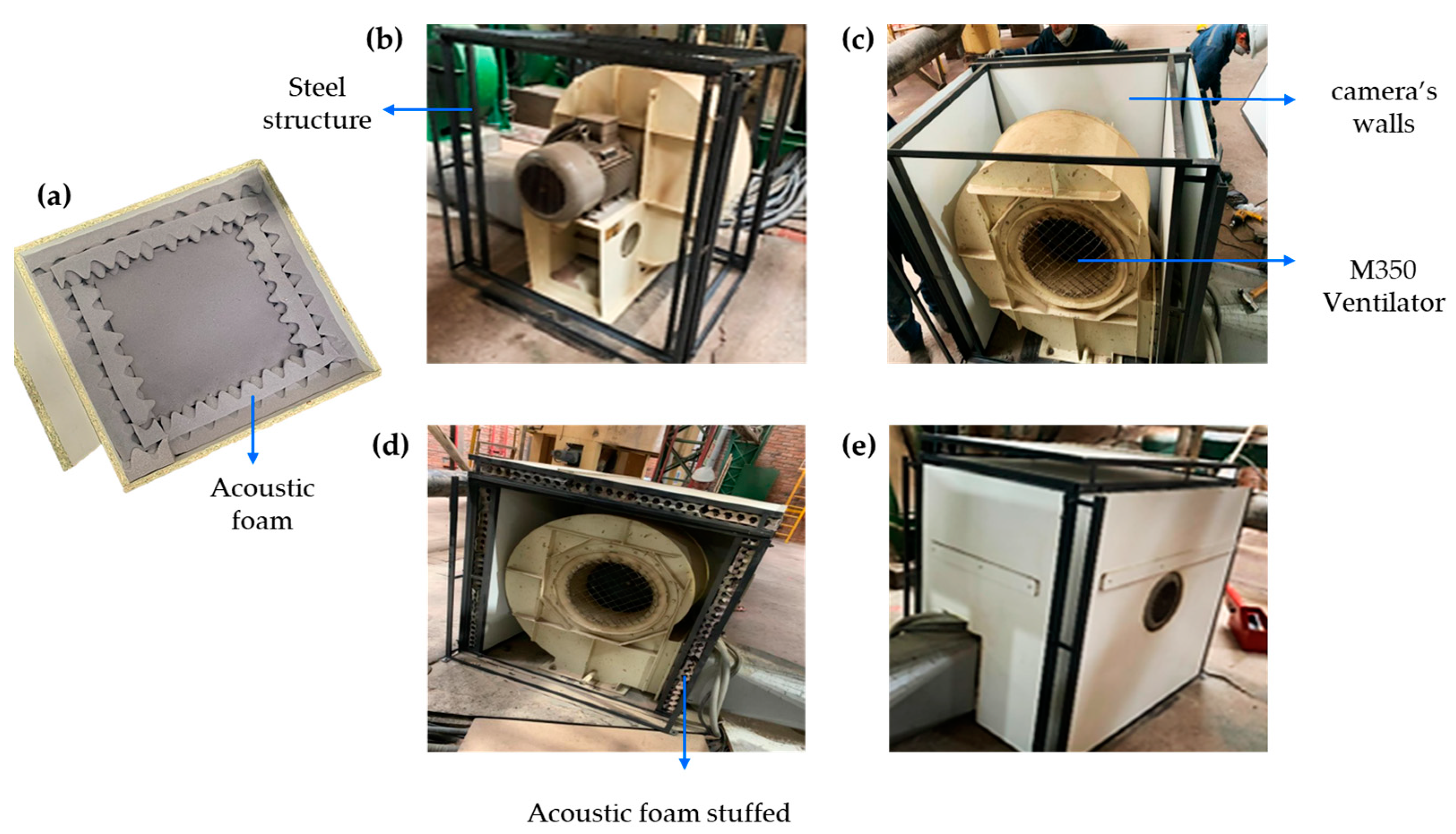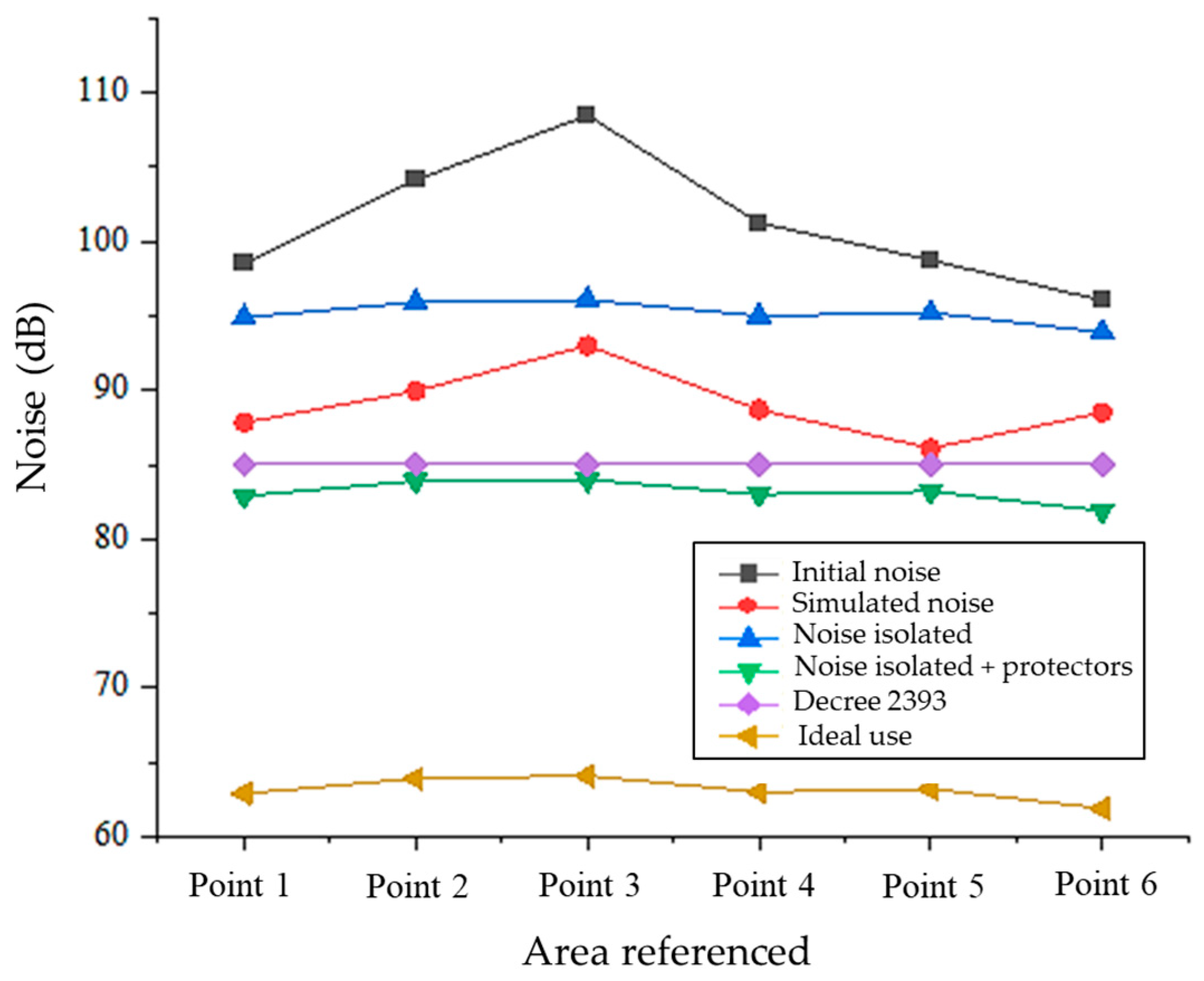Noise Isolation System for Indoor Industrial Ventilation
Abstract
:1. Introduction
2. Materials and Methods
2.1. Regulations in Force in Ecuador
2.2. Data Collection through Engineering Control
2.3. Hearing Shield Evaluation
2.4. Materials Analysis
2.5. Acoustic Camera Design
2.6. Acoustic Camera Operation Simulation
2.7. Manufacture of the Acoustic Camera
3. Results
3.1. Analysis of Materials and Combined Structures
3.2. Acoustic Camera Designs and Simulation
3.3. Manufacturing
4. Discussion
4.1. Selection and Combination of Materials
4.2. Acoustic Chamber Model and Simulation
5. Conclusions
Author Contributions
Funding
Institutional Review Board Statement
Informed Consent Statement
Data Availability Statement
Conflicts of Interest
References
- Sriopas, A.; Chapman, R.S.; Sutammasa, S.; Siriwong, W. Occupational Noise-Induced Hearing Loss in Auto Part Factory Workers in Welding Units in Thailand. J. Occup. Health 2017, 59, 55–62. [Google Scholar] [CrossRef] [Green Version]
- Wang, X.; Orelaja, O.A.; Ibrahim, D.S.; Ogbonna, S.M. Evaluation of Noise Risk Level and Its Consequences on Technical Operators of Tobacco Processing Equipment in a Cigarette Producing Company in Nigeria. Sci. Afr. 2020, 8, e00344. [Google Scholar] [CrossRef]
- Karasmanaki, E. Is It Safe to Live near Wind Turbines? Reviewing the Impacts of Wind Turbine Noise. Energy Sustain. Dev. 2022, 69, 87–102. [Google Scholar] [CrossRef]
- Themann, C.L.; Masterson, E.A. Occupational Noise Exposure: A Review of Its Effects, Epidemiology, and Impact with Recommendations for Reducing Its Burden. J. Acoust. Soc. Am. 2019, 146, 3879–3905. [Google Scholar] [CrossRef] [PubMed] [Green Version]
- Osejos-Merino, M.A.; Cano-Andrade, R.J.; Chasing-Guagua, E.A.; Aguilar-Cano, C.A.; Chasing-Salazar, S.A. Acoustic pollution and its incidence in population health along Alejo Lascano Avenue in Jipijapa city – Ecuador. Domino Cienc. 2019, 5, 538–559. [Google Scholar] [CrossRef]
- Zhang, H.-D.; Yuan, F.; Jin, N.; Deng, H.-X. The Combined Effect of Elevated Blood Pressure and Occupational Noise Exposure on Bilateral High-Frequency Hearing Loss: Evidence From a Large Sample Cross-Sectional Study. J. Occup. Environ. Med. 2023, 65, e219. [Google Scholar] [CrossRef]
- King, E. Noise Control and Its Relationship with the UN Sustainable Development Goals. In Proceedings of the INTER-NOISE and NOISE-CON Congress and Conference Proceedings, Washington, DC, USA, 1–5 August 2021; Volume 263, pp. 4268–4274. [Google Scholar] [CrossRef]
- Naimušin, A.; Januševičius, T. Development and Research of Recyclable Composite Metamaterial Structures Made of Plastic and Rubber Waste to Reduce Indoor Noise and Reverberation. Sustainability 2023, 15, 1731. [Google Scholar] [CrossRef]
- Bettarello, F.; Gasparella, A.; Caniato, M. The Influence of Floor Layering on Airborne Sound Insulation and Impact Noise Reduction: A Study on Cross Laminated Timber (CLT) Structures. Appl. Sci. 2021, 11, 5938. [Google Scholar] [CrossRef]
- Liu, X.; Zhao, D.; Guan, D.; Becker, S.; Sun, D.; Sun, X. Development and Progress in Aeroacoustic Noise Reduction on Turbofan Aeroengines. Prog. Aerosp. Sci. 2022, 130, 100796. [Google Scholar] [CrossRef]
- Kanase, M.M.; Chaudhari, M.B. Design, Manufacturing and Validation of Low Cost, Miniature Acoustic Chamber. Noise Vib. Worldw. 2015, 46, 24–35. [Google Scholar] [CrossRef]
- Bocanegra, J.A.; Borelli, D.; Gaggero, T.; Rizzuto, E.; Schenone, C. A Novel Approach to Port Noise Characterization Using an Acoustic Camera. Sci. Total Environ. 2022, 808, 151903. [Google Scholar] [CrossRef] [PubMed]
- Mayorga, D.A.M.; Morejón, E.A.A. Hipoacusia inducida por ruido ocupacional (revisión de la literatura). Recimundo 2022, 6, 276–283. [Google Scholar] [CrossRef]
- Chen, A.; Zhao, X.; Yang, Z.; Anderson, S.; Zhang, X. Broadband Labyrinthine Acoustic Insulator. Phys. Rev. Appl. 2022, 18, 064057. [Google Scholar] [CrossRef]
- Pereira, A.; Gaspar, A.; Godinho, L.; Amado Mendes, P.; Mateus, D.; Carbajo, J.; Ramis, J.; Poveda, P. On the Use of Perforated Sound Absorption Systems for Variable Acoustics Room Design. Buildings 2021, 11, 543. [Google Scholar] [CrossRef]
- Bellucci, V.; Flohr, P.; Paschereit, C.O.; Magni, F. On the Use of Helmholtz Resonators for Damping Acoustic Pulsations in Industrial Gas Turbines. J. Eng. Gas Turbines Power 2004, 126, 271–275. [Google Scholar] [CrossRef]
- Grigg, S.; Al-Shibaany, Z.Y.A.; Pearson, M.R.; Pullin, R.; Calderbank, P. Acoustic Sensing and Noise Identification of a Heating, Ventilation and Air Conditioning Unit: Industrial Case Study. Appl. Sci. 2021, 11, 9811. [Google Scholar] [CrossRef]
- Dong, R.; Sun, M.; Mo, F.; Mao, D.; Wang, X.; Li, Y. Recent Advances in Acoustic Ventilation Barriers. J. Phys. D Appl. Phys. 2021, 54, 403002. [Google Scholar] [CrossRef]
- Fiebig, W.; Dąbrowski, D. Use of Acoustic Camera for Noise Sources Localization and Noise Reduction in the Industrial Plant. Arch. Acoust. 2020, 45, 111–117. [Google Scholar]
- Chen, D.-C.; Wei, Q.; Yan, P.-Y.; Zhu, X.-F.; Wu, D.-J. Sound Insulation via a Reconfigurable Ventilation Barrier with Ultra-Thin Zigzag Structures. J. Appl. Phys. 2021, 129, 064502. [Google Scholar] [CrossRef]
- Kang, C.-W.; Kim, M.K.; Jang, E.-S. An Experimental Study on the Performance of Corrugated Cardboard as a Sustainable Sound-Absorbing and Insulating Material. Sustainability 2021, 13, 5546. [Google Scholar] [CrossRef]
- Kishore, S.E.; Sujithra, R.; Dhatreyi, B. A Review on Latest Acoustic Noise Mitigation Materials. Mater. Today Proc. 2021, 47, 4700–4707. [Google Scholar] [CrossRef]
- OSHA Technical Manual (OTM)|Occupational Safety and Health Administration. Available online: https://www.osha.gov/otm (accessed on 1 April 2023).
- Noise and Occupational Hearing Loss|NIOSH|CDC. Available online: https://www.cdc.gov/niosh/topics/noise/default.html (accessed on 1 April 2023).
- Noise Source Regulation in State and Local Noise Ordinances. Available online: https://rb.gy/v7l91 (accessed on 1 April 2023).
- ANSI/ASA S3.1-1999 (R2018)-Maximum Permissible Ambient Noise Levels for Audiometric Test Rooms. Available online: https://webstore.ansi.org/standards/asa/ansiasas31999r2018 (accessed on 1 April 2023).
- IEC 60601-1-8:2006(En), Medical Electrical Equipment—Part 1–8. Available online: https://www.iso.org/obp/ui/#iso:std:iec:60601:-1-8:ed-2:v1:en (accessed on 1 April 2023).
- Directive 2003/10/EC-Noise|Safety and Health at Work EU-OSHA. Available online: https://osha.europa.eu/en/legislation/directives/82 (accessed on 1 April 2023).
- Berglund, B.; Lindvall, T.; Schwela, D.H.; World Health Organization; Occupational and Environmental Health Team. Guidelines for Community Noise; World Health Organization: London, UK, 1999. [Google Scholar]
- Standards and Guidelines. Available online: https://www.ashrae.org/technical-resources/standards-and-guidelines (accessed on 22 May 2023).
- ISO 21940-11:2016; Mechanical Vibration—Rotor Balancing—Part 11: Procedures and Tolerances for Rotors with Rigid Behaviour. Available online: https://www.iso.org/standard/54074.html (accessed on 22 May 2023).
- Decreto Ejecutivo 2393; Instituto Ecuatoriano de Seguridad Social, 1986; Volume 565, p. 91. Available online: https://www.gob.ec/regulaciones/decreto-ejecutivo-2393 (accessed on 22 May 2023).
- NTE INEN-ISO 3743-1; Norma Técnica. Instituto Ecuatoriano de Normalización, 2014; p. 43. Available online: https://www.normalizacion.gob.ec/buzon/normas/nte_inen_iso_3743-1extracto.pdf (accessed on 22 May 2023).
- INSHT Guía Técnica Para la Evaluación y Prevención de los Riesgos Relacionados Con la Exposición al Ruido-Portal INSST-INSST. Available online: https://www.insst.es/documentacion/catalogo-de-publicaciones/guia-tecnica-para-la-evaluacion-y-prevencion-de-los-riesgos-relacionados-con-la-exposicion-al-ruido (accessed on 19 October 2022).
- Arenas, J.P.; Suter, A.H. Comparison of Occupational Noise Legislation in the Americas: An Overview and Analysis. Noise Health 2014, 16, 306. [Google Scholar] [CrossRef] [PubMed]
- Moreno, C.W.F.Q.; Moya, C.A.M.C.; Domínguez, C.E.R.; Torres, D.Q.; Borja, F.A.M.; Molina, J.O.R. Environmental Impact Evaluation of the Industry of Panela by Life Cycle Analysis. Int. J. Environ. Agric. Biotechnol. 2017, 2, 545–552. [Google Scholar] [CrossRef] [PubMed]
- Vargas, B.; Miño, G.; Vega, P.; Mariño, J.; Vargas, B.; Miño, G.; Vega, P.; Mariño, J. Application of Resource Efficient and Cleaner Production through Best Management Practice in a Pallet Manufacturer Sawmill Located in the City of Puyo-Ecuador. Maderas Cienc. Tecnol. 2019, 21, 367–380. [Google Scholar] [CrossRef]
- Pazmiño, C.L.C.; Alvear, A.G.Q. Evaluation of the Exposure to Noise of Civil Workers When Excavating and Compacting with Pneumatic Equipment in the Sewage Execution Stage: Case Study of Cuenca-Ecuador. AIP Conf. Proc. 2022, 2574, 090009. [Google Scholar] [CrossRef]
- Carrera, G.; Salgado, F.; Villacis, W. Management of Occupational Exposure to Noise at the Technology Transfer Center for Training and Research in Vehicle Emission Control (CCICEV) of the Escuela Politécnica Nacional. Rev. Politécnica 2021, 48, 21–32. [Google Scholar] [CrossRef]
- Cullen, M.R.; Harari, R. Occupational Health Research in Developing Countries: The Experience in Ecuador. Int. J. Occup. Environ. Health 1995, 1, 39–46. [Google Scholar] [CrossRef]
- Celly, Z.J.J. Hearing Loss: A Case Study on the Burden of the Oil Industry. In Proceedings of the SPE International Conference on Health, Safety, and Environment in Oil and Gas Exploration and Production, Nice, France, 15–17 April 2008. [Google Scholar]
- Hayes, M.E.; Hammond, S.; Montgomery, A.P.; Stephenson, L. Improving Hearing Protection Device Noise Attenuation Through Fit-Testing in an Occupational Health Clinic. Workplace Health Saf. 2022, 70, 196–204. [Google Scholar] [CrossRef] [PubMed]
- Bozkurt, T.S. Preparation of Industrial Noise Mapping and Improvement of Environmental Quality. Curr. Pollut. Rep. 2021, 7, 325–343. [Google Scholar] [CrossRef]
- Liptai, P.; Moravec, M.; Badida, M. Research of Possibilities of Using the Recycled Materials Based on Rubber and Textiles Combined with Vermiculite Material in the Area of Noise Reduction. Adv. Mater. Res. 2014, 1001, 171–176. [Google Scholar] [CrossRef]
- Zhang, X.; Hu, X.; Gong, H.; Zhang, J.; Lv, Z.; Hong, W. Experimental Study on the Impact Sound Insulation of Cross Laminated Timber and Timber-Concrete Composite Floors. Appl. Acoust. 2020, 161, 107173. [Google Scholar] [CrossRef]
- Araújo Alves, J.; Neto Paiva, F.; Torres Silva, L.; Remoaldo, P. Low-Frequency Noise and Its Main Effects on Human Health—A Review of the Literature between 2016 and 2019. Appl. Sci. 2020, 10, 5205. [Google Scholar] [CrossRef]









| Sound Level/dB (A) | Exposure Time Per Day/h |
|---|---|
| 85 | 8 |
| 90 | 4 |
| 95 | 2 |
| 100 | 1 |
| 110 | 0.25 |
| 115 | 0.13 |
| Material | Noise Reduction dB (A) | Weight (kg) |
|---|---|---|
| Steel | 17.0 | 280.44 |
| Wood | 10.0 | 25.00 |
| Ceramics | 20.0 | 96.00 |
| Plastic | 4.0 | 10.80 |
| Acoustic foam | 11.7 | 0.83 |
| Steel angles | 8.0 | 1.50 |
| Measures | Point 1 | Point 2 | Point 3 | Point 4 | Point 5 | Point 6 | ||||||
|---|---|---|---|---|---|---|---|---|---|---|---|---|
| dB (A) | F (Hz) | dB (A) | F (Hz) | dB (A) | F (Hz) | dB (A) | F (Hz) | dB (A) | F (Hz) | D B(A) | F (Hz) | |
| Initial values | 97.66 | 655 ± 5 | 103.41 | 659 ± 4 | 106.61 | 94 ± 3 | 99.81 | 93 ± 3 | 97.75 | 331 ± 9 | 94.74 | 257 ± 4 |
| Values after implementation | 94.9 | 20 ± 5 | 95.9 | 57 ± 4 | 99 | 18 ± 4 | 97.5 | 20 ± 3 | 95.2 | 83 ± 6 | 93.9 | 88 ± 5 |
Disclaimer/Publisher’s Note: The statements, opinions and data contained in all publications are solely those of the individual author(s) and contributor(s) and not of MDPI and/or the editor(s). MDPI and/or the editor(s) disclaim responsibility for any injury to people or property resulting from any ideas, methods, instructions or products referred to in the content. |
© 2023 by the authors. Licensee MDPI, Basel, Switzerland. This article is an open access article distributed under the terms and conditions of the Creative Commons Attribution (CC BY) license (https://creativecommons.org/licenses/by/4.0/).
Share and Cite
Escudero-Villa, P.; Fonseca-Gonzales, P.; Núñez-Sánchez, J. Noise Isolation System for Indoor Industrial Ventilation. Sustainability 2023, 15, 9083. https://doi.org/10.3390/su15119083
Escudero-Villa P, Fonseca-Gonzales P, Núñez-Sánchez J. Noise Isolation System for Indoor Industrial Ventilation. Sustainability. 2023; 15(11):9083. https://doi.org/10.3390/su15119083
Chicago/Turabian StyleEscudero-Villa, Pedro, Patricio Fonseca-Gonzales, and Jéssica Núñez-Sánchez. 2023. "Noise Isolation System for Indoor Industrial Ventilation" Sustainability 15, no. 11: 9083. https://doi.org/10.3390/su15119083






